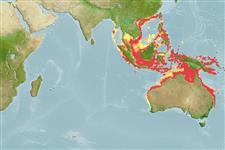Environment: milieu / climate zone / depth range / distribution range
Ekologi
laut; air tawar; payau dasar (demersal); kisaran kedalaman 0 - 100 m (Ref. 6871). Tropical; 28°N - 32°S, 76°E - 165°E (Ref. 114953)
Indo-West Pacific: Thailand to New Guinea and the Solomon Islands, south to Australia. Records from the south coast of India, Sri Lanka, Bangladesh, and Myanmar need confirmation.
Length at first maturity / Size / Weight / umur
Maturity: Lm 165.0, range 150 - 180 cm
Max length : 270 cm TL jantan/; (Ref. 9909)
Occurs inshore and offshore, from the intertidal to offshore continental and insular shelves (Ref. 9909). Adults are found offshore waters while young individuals are found inshore on sand flats, around atolls, and in mangrove swamps (Ref. 6871). Feeds on shellfish, mainly on prawns and crabs (Ref. 9909, Ref. 114953). Ovoviviparous (Ref. 50449). Maturity size at 150-180 cm TL; born at 38-40 cm TL (Ref. 114953). Reported to live and breed permanently in fresh water (Ref. 6871). Probably the major commercial guitarfish in the Western Central Pacific (Ref. 9909). Caught regularly by demersal tangle net fisheries operating throughout the area. Utilized for its meat, fins (both very high value), skin and cartilage (Ref.58048). Reported to attain a maximum length of 4 m (Ref. 58784).
Exhibit ovoviparity (aplacental viviparity), with embryos feeding initially on yolk, then receiving additional nourishment from the mother by indirect absorption of uterine fluid enriched with mucus, fat or protein through specialised structures (Ref. 50449). Born at 38-40 cm TL (Ref.58048).
Last, P.R. and J.D. Stevens, 1994. Sharks and rays of Australia. CSIRO, Australia. 513 p. (Ref. 6871)
Status IUCN Red List (Ref. 130435)
penggunaan manusia
Perikanan: nilai komersial kecil; Akuarium: Komersial
Alat, peralatan
laporan khas
muat turun XML
Sumber internet
Estimates based on models
Preferred temperature (Ref.
123201): 25.7 - 29, mean 28 °C (based on 1126 cells).
Phylogenetic diversity index (Ref.
82804): PD
50 = 0.5156 [Uniqueness, from 0.5 = low to 2.0 = high].
Bayesian length-weight: a=0.00389 (0.00138 - 0.01094), b=3.05 (2.82 - 3.28), in cm total length, based on LWR estimates for this (Sub)family-body shape (Ref.
93245).
Trophic level (Ref.
69278): 3.6 ±0.50 se; based on food items.
Daya lenting (Ref.
120179): Rendah, Waktu penggandaan populasi minimum 4.5 - 14 tahun (Fec assumed to be <100).
Fishing Vulnerability (Ref.
59153): Very high vulnerability (90 of 100).
